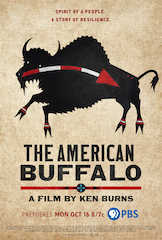PBS’ ‘The American Buffalo’ is emotional, to say the least
Category: Television and Streaming We travel through Yellowstone National Park and marvel at the wildlife. But the Buffalo seem to draw the most interest among visitors to that great, and first, national park. Why are humans so interested in these amazing animals?
We travel through Yellowstone National Park and marvel at the wildlife. But the Buffalo seem to draw the most interest among visitors to that great, and first, national park. Why are humans so interested in these amazing animals?
In the new two-part series “The American Buffalo” from filmmaker Ken Burns, the 10,000 year history of these North American mammals is dissected and to be honest, much of the story is heartbreaking and difficult to watch. Humans almost destroyed these remarkable animals, but thankfully they are on their way back.
The significance to Indigenous People shows how the buffalo were used, revered, and how Europeans took advantage of them. Burns, Consulting Producer Julianna Braunnum, Producer Julia Dunfey, and Historian Rosalyn LaPier recently met virtually with members of the press to discuss this highly important series.
“One of the things in our film that I’m glad that we waited so long to do it was the tendency to freeze people at one particular moment, Buffalo Bill, for example, or a Quanah Parker or a T.R.[Teddy Roosevelt], all of whom undertake and undergo remarkable transformations and changes,” Burns explained, “and to be able to try to create a narrative that was able to understand the way in which Quanah, for example, could go from an attacker at Adobe Walls of the early white settlement in the Texas panhandle, where Julie and Julianna are right now, to being a kind of man of peace, of bringing his people into the reservation, of then hosting Theodore Roosevelt in advance of his creating portions of what is now Oklahoma into the Witchita Mountains game reserve.” According to Burns, the passage of time was significant to be able to tell this story.
When asked about the positive side of the story of the Bison, Burns replied, “It is an unmitigated tragedy. And the first episode is, at times, incredibly difficult to watch when you watch a species that numbered perhaps as many as 50 or 60 million, we had no way of knowing, dwindles down over the course of the 19th century to the mid-80s, down to under a thousand and most of them are in zoos or in private herds and not running wild and free. And so the fact that we have brought the bison back from extinction is itself an accomplishment.” He went on to say that the next step in the lives of the Bison looks encouraging, thanks in large part to the local tribes, historians, and those who care.
“There are also NGOs that are attempting to set aside land large enough to be considered a complete ecosystem that would be able to take these large megafauna, as they’re called, the buffalo, and allow them to do what FDR’s favorite song is, you know, ‘give them a home where the buffalo roam, and the deer and the antelope play.’”
LaPier added, “Indigenous people have been managing the land and landscape of North America for thousands of years. And the Menominee tribe in the 20th century and 21st century, they’re award-winning land managers. They have managed their forest and they have done a great job of this, and so them being able to return bison to their own ancestral homelands is something that will fit perfectly within their own land management practices that they’ve been doing for a very long time.”
One question on everyone’s mind is their name. Are they Bison or Buffalo? Burns finally set the record straight.
“So scientists call it bison-bison. People call it buffalo, even the National Bison Refuge has been changed to the National Buffalo Refuge. I don’t think Buffalo Bill would want his name changed to Bison Bill nor would the second largest city in New York state like to be changed to Bison, New York. So just there you have it. We have a scientific name, and we kind of have a popular name, and the popular name obtains — and it’s also interchangeable and people, as you’ve heard in this conversation, we say bison and buffalo. They’re not actually buffalo, but that’s what the name that they were given, and prairie dogs are not actually dogs. So we’ve got a complex set of things.”
The two-part four-hour film is sad, historic, touching, yet hopeful. Burns mentioned, “Our second episode begins in introduction with a quote from [writer/historian] Wallace Stegner who says, ‘Humans are the most dangerous species on earth, and every other species, including the earth itself, has reason to worry and fear us. But we are the only species, when we want to, that can save another.’”
About the Author
Francine Brokaw has been covering all aspects of the entertainment industry for over 30 years. She also writes about products and travel. She has been published in national and international newspapers and magazines as well as Internet websites. She has written her own book, Beyond the Red Carpet The World of Entertainment Journalists, is the entertainment correspondent for Good Day Orange County, and has her own TV show, Beyond the Red Carpet, on Village Television in Orange County. She is a longstanding member of the Television Critics Association and is accredited by the MPAA. Follow her on Twitter.
